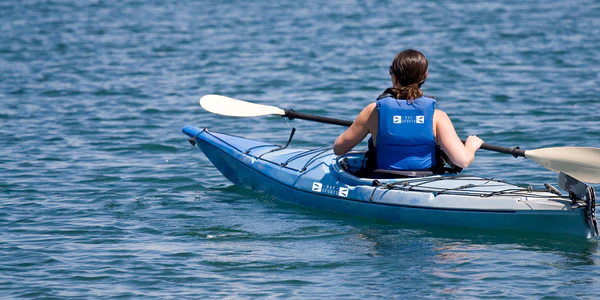Kayaking has evolved from a niche water activity to a widely embraced recreational sport. As more individuals venture into the serenity of open waters, it becomes crucial to emphasize the significance of safety. This article delves into the 10 safety tips every kayaker should know, ensuring a secure and enjoyable paddling experience.
Essential Safety Gear
Definition and Importance of Personal Flotation Devices (PFDs)
Kayaking safety starts with the right gear, and at the forefront is the Personal Flotation Device (PFD). Also known as life jackets, PFDs are not just a legal requirement; they are a lifeline in emergencies. Statistics show that wearing a PFD significantly reduces the risk of drowning while kayaking. Always choose a Coast Guard-approved PFD suitable for your weight and the type of kayaking you’re engaged in.
Types of PFDs and How to Choose the Right One
Understanding the various types of PFDs is crucial. For calm waters, a Type III PFD with a snug fit and freedom of movement is ideal. In rougher conditions, consider a Type V PFD, designed for specific water activities. When selecting a PFD, ensure it’s well-fitted, properly adjusted, and regularly inspected for any signs of wear.
Additional Safety Gear
In addition to PFDs, there are other essential safety gears that every kayaker should have. A whistle is a simple yet effective signaling device, helping you alert others in case of distress. Carrying a first aid kit in a waterproof container ensures you are prepared for minor injuries and emergencies. Investing in a marine-grade flashlight adds an extra layer of safety during low light conditions.
Weather and Water Conditions
Understanding Weather Patterns Before Kayaking
Before embarking on a kayaking adventure, it’s imperative to be well-versed in local weather patterns. Check reliable weather forecasts and advisories to avoid unexpected storms or adverse weather conditions. Strong winds, thunderstorms, and rapidly changing temperatures can pose serious risks to kayakers.
Checking Weather Forecasts and Advisories
Utilize weather apps, websites, or local news channels to stay updated on real-time weather forecasts. Pay attention to wind speed, precipitation, and temperature fluctuations. Understanding the weather forecast ensures you plan your kayaking trip on days with optimal conditions, minimizing potential hazards.
Assessing Water Conditions for Safe Paddling
Beyond understanding the weather, assessing water conditions is equally important. Factors such as water temperature, currents, and tides can significantly impact your kayaking experience. Check local water conditions and research the water body you plan to navigate. Understanding these aspects ensures you are well-prepared for any challenges the water may present.
Proper Kayak Selection and Maintenance
Choosing the Right Kayak for Your Skill Level
Selecting the right kayak is paramount for a safe and enjoyable paddling experience. Kayaks come in various types, including sit-on-top, sit-inside, recreational, touring, and whitewater kayaks. Your choice should align with your skill level, the type of water you’ll be navigating, and your intended activities. Novice kayakers often find stability in wider, recreational kayaks, while experienced paddlers may prefer sleeker, more maneuverable models.
Regular Maintenance and Inspection Tips
Once you’ve chosen the perfect kayak, regular maintenance is key to ensuring its longevity and your safety. Inspect your kayak before each outing, checking for any cracks, leaks, or signs of wear. Ensure all hatches and compartments are sealed properly. Regularly clean and lubricate moving parts, such as hinges and rudders. Performing these routine checks enhances the overall performance and safety of your kayak.
Ensuring Proper Kayak Fit for Optimal Control
The fit of your kayak is as important as the type. A poorly fitted kayak can compromise your control and stability. Adjust the footrests and seat to ensure a comfortable and snug fit. When seated, your knees should be slightly bent, and you should have easy access to the paddle. This proper fit not only enhances your control but also reduces the risk of strain and discomfort during extended paddling sessions.
Learn Basic Kayaking Techniques
Paddling Strokes and Maneuvers
Mastering basic kayaking techniques is fundamental for both efficiency and safety on the water. Begin with the forward stroke, keeping your torso engaged and rotating with each paddle stroke for maximum power. Learn the reverse stroke for quick stops and backward movement. Practice the sweep stroke to turn your kayak smoothly, and the draw stroke to pull the kayak sideways. Understanding these strokes ensures better control and maneuverability.
Evasive Actions and Emergency Maneuvers
In the face of unexpected challenges, knowing evasive actions and emergency maneuvers is crucial. Practice the low brace for stability in rough waters and the high brace to prevent capsizing. Familiarize yourself with the edging technique, tilting the kayak to control turns without losing stability. Regularly practice these maneuvers in a controlled environment to build muscle memory and confidence when facing real-life scenarios.
Tips for Efficient and Safe Paddling
Efficiency in paddling not only conserves energy but also contributes to a safer kayaking experience. Keep a relaxed grip on the paddle to reduce strain on your wrists and shoulders. Engage your core muscles for stability and power. Practice maintaining a steady pace to avoid exhaustion. Understanding the balance between speed, technique, and energy conservation enhances both your performance and safety on the water.
Know Your Limits
Self-Assessment of Physical Fitness and Skill Level
Acknowledging your physical fitness and skill level is a critical aspect of kayaking safety. Assess your cardiovascular endurance, strength, and flexibility. Be honest about your swimming ability. Understanding your fitness level ensures you choose appropriate water conditions and kayak types, reducing the risk of exhaustion or injury.
Recognizing and Respecting Personal Limitations
While kayaking can be an exhilarating activity, it’s crucial to recognize and respect your personal limitations. Avoid pushing yourself beyond your comfort zone, especially in challenging conditions. If you’re a novice, start with calm waters and gradually progress to more demanding environments as your skills and confidence grow. Understanding and respecting your limits is a key component of responsible kayaking.
Importance of Gradually Advancing Skill Levels
Kayaking is a skill that develops over time. Instead of attempting advanced maneuvers or challenging waters right away, focus on gradually advancing your skill levels. Take lessons, practice in controlled environments, and seek guidance from experienced kayakers. This gradual progression not only enhances your safety but also deepens your enjoyment and appreciation of the sport.
Familiarity with Local Regulations
Researching and Understanding Local Water Regulations
Each water body has its own set of regulations and guidelines. Research and understand the local water regulations before embarking on a kayaking adventure. Some areas may have specific rules regarding navigation, speed limits, and protected zones. Adhering to these regulations not only ensures your safety but also contributes to the preservation of natural ecosystems.
Knowledge of Restricted Areas and Permits
Certain water bodies may have restricted areas to protect sensitive ecosystems or wildlife habitats. Obtain information about these restricted zones and adhere to any permit requirements. Failure to comply with regulations can result in fines and negatively impact the environment. Responsible kayakers prioritize environmental conservation and respect designated areas.
Complying with Environmental Conservation Guidelines
Beyond regulations, kayakers play a role in environmental conservation. Avoid disturbing wildlife, especially during nesting seasons. Dispose of trash responsibly and participate in local cleanup efforts. Adhering to environmental guidelines ensures the sustainability of kayaking destinations for future generations.
Buddy System and Communication
Benefits of Kayaking in Pairs or Groups
Embracing the buddy system significantly enhances kayaking safety. Paddling with a companion or in a group offers several advantages. In case of an emergency, having someone nearby provides immediate assistance. Additionally, group kayaking fosters a sense of camaraderie, shared experiences, and the opportunity to learn from one another. Whether you’re a seasoned kayaker or a beginner, the buddy system ensures that someone is there to help and share the enjoyment of the journey.
Establishing Communication Signals
Effective communication is vital when kayaking with others, especially in large bodies of water or challenging conditions. Develop and use clear communication signals to convey information to your kayaking companions. Standard signals include hand gestures, whistle blows, or pre-established codes for specific situations. Ensure that everyone in your group is familiar with these signals to facilitate quick and efficient communication while on the water.
Staying Connected on the Water
In the age of technology, staying connected on the water has become more accessible and enhances safety. Consider using waterproof communication devices such as two-way radios or marine-grade walkie-talkies. These devices allow real-time communication, making it easier to coordinate movements, share observations, or call for assistance if needed. While enjoying the beauty of nature, maintaining communication ensures a secure and enjoyable kayaking experience.
Emergency Preparedness
Creating an Emergency Action Plan
No matter how well-prepared you are, emergencies can still occur. Having an emergency action plan in place is crucial for swift and effective response. Your plan should include procedures for capsizing, injuries, or getting separated from your group. Share the plan with your kayaking companions and review it before each outing. Being proactive in emergency preparedness enhances your ability to handle unexpected situations with confidence.
Carrying a Waterproof Communication Device
Investing in a waterproof communication device is a fundamental aspect of emergency preparedness. Cell phones may not be reliable on the water, but devices designed for marine environments offer a reliable means of communication. Ensure your communication device is properly sealed in a waterproof case or bag to protect it from water exposure. Having a reliable communication tool can be a lifeline in critical situations.
Knowing How to Signal for Help
In case of emergencies, knowing how to signal for help is crucial. Carry a whistle as a basic signaling device. Three short blasts are widely recognized as a distress signal. Additionally, using visual signals such as waving your paddle or flashing a light can attract attention. Familiarize yourself with distress signals and teach them to your kayaking companions to ensure a coordinated response in emergency situations.
Wildlife Awareness
Identifying and Respecting Local Wildlife
Kayaking provides a unique opportunity to witness wildlife in their natural habitats. However, it’s essential to identify and respect the local wildlife. Educate yourself about the species you might encounter and the behaviors indicative of stress or agitation. Maintain a safe distance to avoid disturbing animals, especially during sensitive times such as mating or nesting seasons.
Safety Precautions for Encounters with Marine Life
While rare, kayakers may encounter marine life such as dolphins, seals, or even larger animals like whales. Stay calm and observe from a distance, giving wildlife plenty of space. Avoid feeding or attempting to touch animals, as this can disrupt their natural behavior and pose risks to both parties. Familiarize yourself with local guidelines for wildlife interactions and prioritize the well-being of the creatures you encounter.
Environmental Stewardship While Kayaking
Responsible kayakers are also environmental stewards. Take proactive steps to minimize your impact on the ecosystems you explore. Avoid disturbing vegetation along shorelines, and steer clear of sensitive habitats like seagrass beds or coral reefs. Dispose of any trash properly and consider participating in local conservation efforts. By prioritizing environmental stewardship, kayakers contribute to the preservation of pristine water environments for future generations.
Training and Certification
The Importance of Kayaking Lessons
No matter your level of experience, taking kayaking lessons is a valuable investment in your safety and enjoyment. Professional instructors can teach you essential skills, proper techniques, and safety protocols. Whether you’re a beginner or an experienced paddler, structured lessons provide the opportunity to refine your abilities, enhance your confidence, and gain insights from experienced mentors.
Seeking Certification from Recognized Organizations
For those serious about kayaking, obtaining certification from recognized organizations adds credibility to your skills. Organizations like the American Canoe Association (ACA) offer certification programs that cover safety, navigation, and advanced paddling techniques. Certification not only validates your proficiency but also ensures you have a comprehensive understanding of kayaking safety standards.
Continuous Learning and Skill Improvement
The learning journey in kayaking never truly ends. Even experienced kayakers can benefit from continuous learning and skill improvement. Attend workshops, participate in advanced courses, and stay informed about the latest safety guidelines and equipment innovations. Embracing a mindset of continuous improvement not only enhances your safety on the water but also deepens your appreciation for the art of kayaking.
Conclusion
In conclusion, mastering the waters requires a combination of knowledge, skills, and a commitment to safety. The 10 safety tips covered in this article provide a comprehensive guide for kayakers of all levels. From essential safety gear and understanding weather conditions to proper kayak selection, basic techniques, and environmental stewardship, these tips are the foundation for a secure and enjoyable kayaking experience.
By adopting the buddy system, staying prepared for emergencies, being mindful of wildlife, and investing in training and certification, kayakers can elevate their skills and contribute to the preservation of our water environments. Whether you’re a novice exploring calm rivers or an experienced paddler tackling challenging waters, prioritizing safety ensures a lifetime of fulfilling and secure kayaking adventures.





